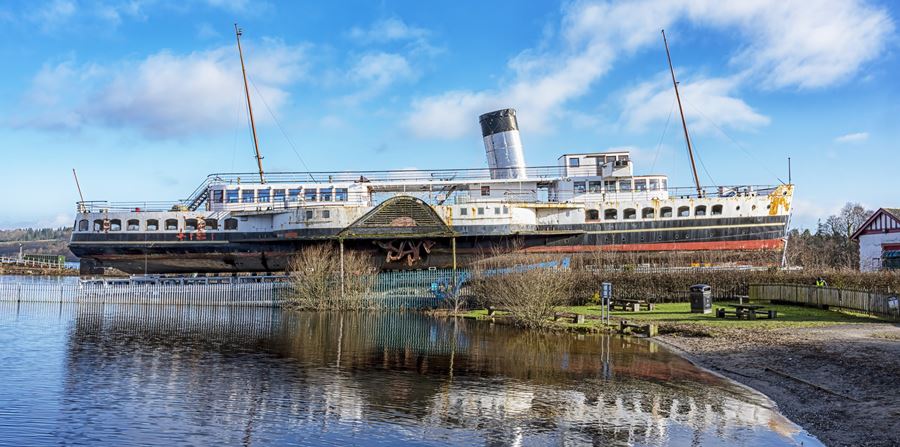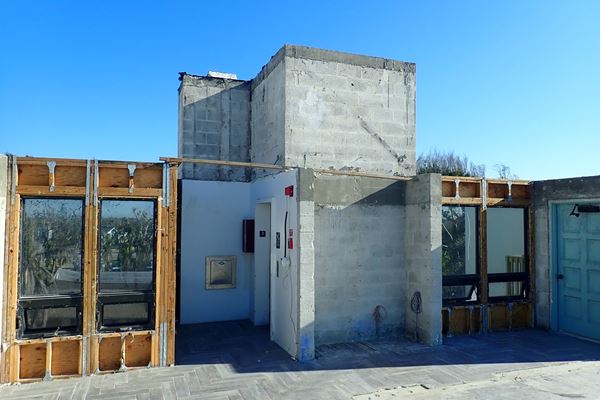Marine Engine Failure from Arcing?

When you think about island life, images of palm trees and carefree living come to mind. It’s easy to let practical matters fade as you relax. However, if you live on an island, the regularly scheduled ferry to the mainland is a lifeline for residents and visitors and a daily necessity. It is used as a school bus to transport school children on and off the island and a means of transportation for law enforcement matters and emergency services, such as fires or emergency medical services. When the ferry is not running, the consequences can widely range from being a minor inconvenience to being a serious matter of public safety or even a matter of life or death.
Background Story
The ferry travelled daily on its 15 to 20-minute voyage from the mainland to one of the nearby islands multiple times a day. Due to bottom shoaling, the area around the dock at the island was being dredged to increase the depth at the dock and reduce the chances of an accidental grounding. The ferry was moored at a dock on the island side of its daily route along with the dredge vessel.
Since there is no onboard generator on the ferry, it relies on a battery bank located in the ferry’s engine room for electrical power. As with any vehicle battery, it does require charging to maintain its voltage and power to equipment on the vessel. The battery charger is typically a 120VAC device and requires power similar to devices in your home. Typically, marine devices, such as navigation electronics, engine electronics, lighting, and electro/mechanical systems, run on DC power sourced from a battery bank.
The source of 120VAC power for the battery charger via a shore power cord connects between a receptacle on the ferry and a power pedestal on the dock. The shore power cord is similar to a common extension cord. For this ferry, the distance between the power pedestal and the shore power connection on the boat was greater than the length of one shore power cord so two were connected.
Trouble at Sea
One evening, the dredge began to drift. Normally, an automated system onboard the dredge would activate as it drifted and engage spikes that would extend out of the bottom of the dredge, push into the ocean bottom, and hold it in place. Unfortunately, this system did not activate, and the dredge drifted into the ferry and impacted it. Although the ferry is a very strong steel-hulled vessel, areas of the hull were scratched, dented, and damaged.
Due to the impact, the ferry was pushed by the dredge and caused damage to the dock as the cleats and bollards were ripped from the wooden planking on the dock. As the ferry’s moorings were torn out, the ferry drifted and caused the shore power cord to dip into the water. As luck would have it, the portion of the shore power cord that dipped into the water was where the connection between the two power cords was and caused arcing to occur at the connection.
After this occurred, the ferry operator stated that the electronics for the ferry’s engine controls required replacement and may be attributed to the shore power cable dipping into the water and arcing. With the ferry’s engine not running, there was an interruption in service, which was highly undesirable. It was unknown if there was a correlation between the shore power cable arcing, possible power surge, and the engine controller failure but it was suspicious to the owner since they occurred within just days of each other.
Envista in Action
Envista Forensics was retained as an independent third-party engineer, representing the owner of the ferry, tasked to determine the scope, extent of damage, and root cause. A review of documentation was conducted, followed by a scheduled inspection of the subject ferry. Although time is typically of the essence, repairs were stated to have been completed and the ferry was running its normal scheduled trips back and forth to the island. Envista’s timing to arrive at the dock when the ferry first arrived at the mainland was important to minimize any interruptions in service.
The Initial Investigation: Gathering Evidence Onboard the Vessel
Upon arrival, a meeting with the vessel’s captain occurred to gather relevant background information and establish a timeline of events. The ferry itself was relatively new, only two to three years old when the impact occurred. The impacted area was inspected by Envista, and the damage was found to be mostly cosmetic in nature with scuffed paint and scratches but no hull breaches. The ferry was built by a local boatbuilder and had replaced the previous ferry that had been in service for over 34 years. The steel-hulled vessel was 56 feet in length, had three crew members, and transported more than 155,000 passengers making almost 4,000 scheduled trips each year.
Although much information was obtained in Envista’s review of the documents prior to the inspection, speaking with and interviewing the individuals directly involved is invaluable, brings context to existing information, and new important information is often obtained. This is the opportunity for those involved to tell their story. As this was an operating ferry with passengers, Envista conducted an inspection and documentation of electrical and electronic systems in the wheelhouse. Verification of both AC and DC electrical systems was conducted to help determine if there is a pattern of damage consistent with a surge event as claimed. Electrical surge does not only damage one piece of equipment when it occurs, as there are almost always multiple paths for a surge to take, and many times through sensitive electronic equipment. In this case, through interviews and inspection, it was determined that there was no pattern of damage, and all of the DC electronics were operating normally.
Once the vessel reached the island and offloaded its passengers, Envista was guided to the hatch on the main deck that led via a short ladder to the engine room. The engine room contained the vessel’s engine and its electronic controls, the AC and DC electrical distribution, batteries, and the battery charger. The vessel’s electrical system was similar to an uninterruptable power supply (UPS), or battery backup that is used for home electronics, but on a much larger scale. The shore cord supplies 120V power to a large inverter, a device that transforms DC current from a battery bank to AC current, that can be used by 120V appliances. The inverter also acts as the battery charger for the battery bank, so it is an all-in-one device. What is important in this configuration is that the AC power from the shore cord and the DC power supplied by the batteries are completely separated and not compatible with each other. Unless a catastrophic electrical event occurred that damaged or destroyed the inverter, there could be no electrical path between the AC and the DC portions of the vessel’s electrical systems. Since the inverter was undamaged and operating properly, there was no probability of a surge in the vessel’s DC electrical system. Since the vessel’s engine controls all operate on 12VDC, further investigation into the root cause was conducted.
The electrical systems in the engine room were inspected and documented to further gain knowledge of the design of the system. This included circuit breaker panels, the engine itself, and ancillary electro-mechanical systems. Modern marine engines are extremely complicated as they rely on advanced electronic controls in order to boost efficiency and reliability and allow for multiple control stations for throttle, start/stop, and engine monitoring. Engine systems can become complicated very quickly as data communication lines and control wires must be connected throughout the vessel. On this vessel, the wheelhouse had two remote control stations, and each had its own set of monitoring and controls. There was also a module with a display mounted on the wall near the ladder that led to the engine room from the main deck. This is the module that was stated to have been replaced along with engine start/stop switches in the wheelhouse. From Envista’s investigation, these components for the engine were the only devices determined to have required replacement. With an isolated electrical item replaced and no pattern of damage present, surge from the shore cord was not probable. However, it was discovered that the engine service company still had the parts available for inspection and would be critical in determining the root cause of the engine failure with certainty.
Phase Two: Inspection of the Damaged Components
Envista made arrangements to travel to the engine repair company’s facility located relatively close to the ferry and inspect the components found damaged. Evidence of electrical arcing or surge would include charring or blackening of components, burned or visibly damaged circuit board, melted cabling, or blown fuses. Evidence of water ingress was also to be investigated since in a marine environment, water could be one of the causes of failure.
The engine control module, a small box with multiple connections for cables to be connected to the box, was presented for inspection. These connections included power to the module, inputs and outputs, and communication cabling for connection to the engine communications network. This module was a critical component in the engine system and a failure in the module would not allow the engine to run. Although this was not the brain of the engine, it was part of the engine’s nervous system and critical to its operation.
During the visual inspection of the engine control module, both an external and internal visual inspection was conducted using magnification and digital macro photography. Each of the components mounted to the printed circuit board and the board itself were inspected and no evidence of damage was observed. Closer inspection however did exhibit an anomaly in the pins of a multi-pin connector. This connector was soldered directly to the circuit board and then exited the box for a mating connector to plug into. Two of the pins on the connector at the circuit board were examined more closely and found to have been physically bent upward, consistent with the connector being torqued upward. This damage was consistent with the cable connection being pulled forcefully or possibly the box itself used as a step and bending the pins since it was located nearby the ladder. When the pins were bent, they pulled the connector out of the board, fracturing the solder connections, and causing permanent damage. The mechanical damage to the circuit board in the engine control module was determined to be the root cause of the failure. No evidence of surge damage or electrical arcing was found anywhere on the vessel or in the engine control module.
The Outcome
After reviewing provided documents, conducting research into system operability, conducting an inspection on board the ferry, and inspecting the claimed failed components, the cause of the engine failure was determined by Envista as not attributed to electrical arcing but instead, mechanical damage from overstress. Envista helped determine the impact of the dredge and the subsequent engine failure were not related events. With mechanical damage being found as the root cause, the owner of the vessel was put at ease knowing that a surge or arcing did not occur on board and it was not probable that further unknown surge-related damage occurred. The ferry continues to operate today, months after the collision event without issue.
Our experts are ready to help.


